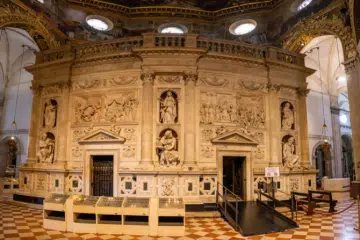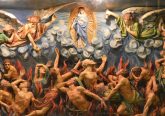God the Father & God the Son

How can Jesus be God and God’s son?
One of our Catholic faith’s greatest mysteries is the Trinity: God in three Persons. The word “trin- ity” is not found in the Bible, though God the Father, Son, and Spirit are mentioned by name and in relation to each other according to their activity.
Consequently, the early Christians believed in the Trinity before they used the word. The Church grappled with determining the correct language to describe it and what can be said (and not said) about Father, Son, and Spirit collectively and in- dividually.
Only Begotten Son
The members of the Trinity are divine: God the Father is truly divine, just as God the Son and the Holy Spirit are. Yet they are distinct persons. But this can be difficult to conceive and explain.
The Father and Son’s eternal relationship of fatherhood and sonship is manifested in the mystery of the Incarnation: God taking on human flesh. Jesus is God’s “only begotten son” eternally and temporally. He was made known in time, yet existed for all ages. As the Nicene Creed teaches, Jesus was “born of the Father before all ages,” which is to say He always existed. According to the Father’s plan, He took on human form: “He came down from heaven, and by the Holy Spirit was incarnate of the Virgin Mary, and became man.”
In becoming man, Jesus was no less God. As articulated in the Creed, Jesus is “begotten, not made, consubstantial with the Father.” This means that God the Father and God the Son are of the same divine essence and, thus, are equal.
Two Natures
Jesus is truly God and truly man, possessing two natures—divine and human—united in a single Person. This was a subject of dispute until the 400s, when Pope Leo arrived at the formulation: Jesus is fully God and fully man. His two natures “undergo no confusion, no change, no division, no separation.” The term “hypostatic union” (a technical phrase derived from the Greek word for “person”) has been used to describe the union of the divine and human natures in the one person of Jesus Christ.
But this does not mean that everything that can be said of the Father can be said of the Son. For instance, God the Father did not suffer and die on the Cross—only Jesus, the Son, did.
God Made Visible
Jesus is the image of the invisible God. Through His incarnation, the invisible God becomes visible to give us a model for becoming like God. As the Church teaches, the “Son of God became man so that we might become God” (Catechism of the Catholic Church, 460). Jesus provides a perfect example for humanity to follow: He shows us the pathway to God.
That God came among us as a man provides the opportunity for salvation. This is not despite His taking on human flesh, but because He has taken on our nature. As the Church Father Gregory of Nazianzus taught, “What has not been assumed, has not been healed.” By becoming man, Jesus became the second Adam. He undid the sin of our first parents, Adam and Eve.
Jesus is God; He is also God’s son. If it were not so, we could not be saved. We thank God for the gift of the Son, by whom we are ransomed from sin and death. By becoming like us in all things but sin, Jesus has shown us the way to the Father.
 Father David Endres, [email protected], is professor of Church history and historical theology at Mount St. Mary’s Seminary & School of Theology.
Father David Endres, [email protected], is professor of Church history and historical theology at Mount St. Mary’s Seminary & School of Theology.
This article appeared in the June 2025 edition of The Catholic Telegraph Magazine. For your complimentary subscription, click here.













